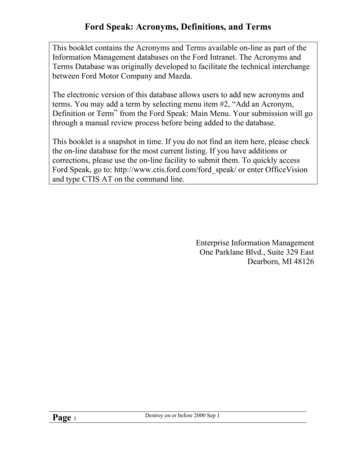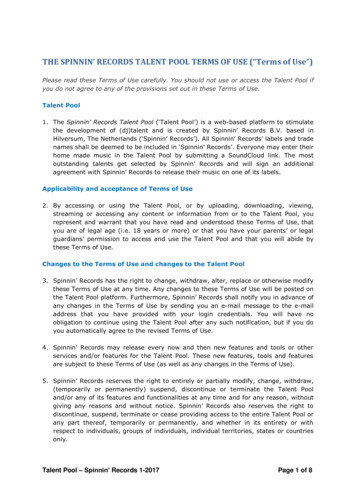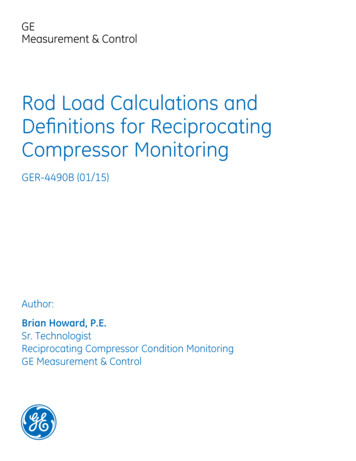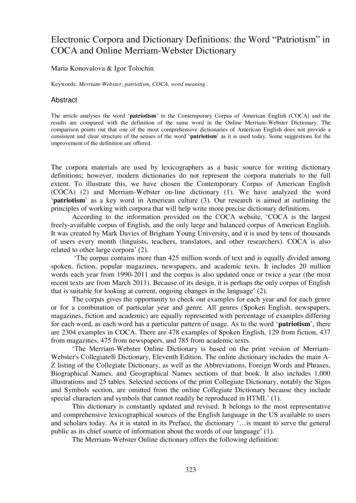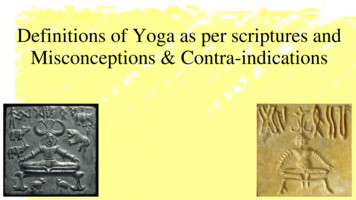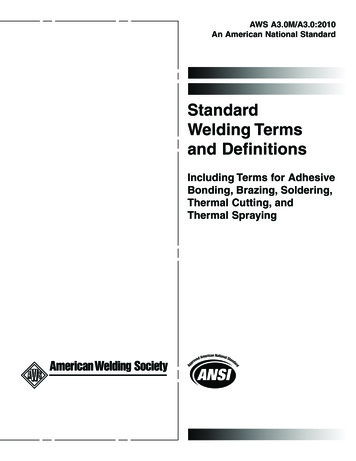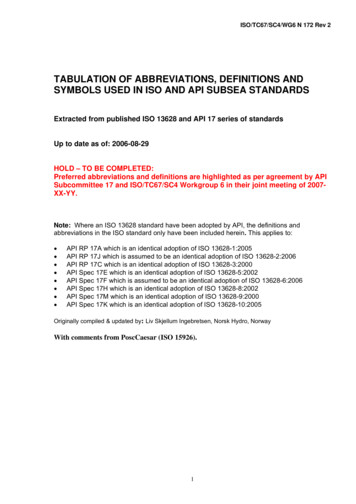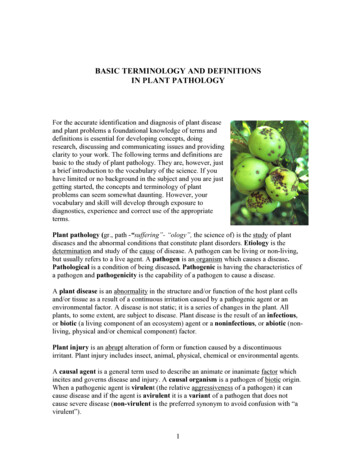
Transcription
BASIC TERMINOLOGY AND DEFINITIONSIN PLANT PATHOLOGYFor the accurate identification and diagnosis of plant diseaseand plant problems a foundational knowledge of terms anddefinitions is essential for developing concepts, doingresearch, discussing and communicating issues and providingclarity to your work. The following terms and definitions arebasic to the study of plant pathology. They are, however, justa brief introduction to the vocabulary of the science. If youhave limited or no background in the subject and you are justgetting started, the concepts and terminology of plantproblems can seem somewhat daunting. However, yourvocabulary and skill will develop through exposure todiagnostics, experience and correct use of the appropriateterms.Plant pathology (gr., path -“suffering”- “ology”, the science of) is the study of plantdiseases and the abnormal conditions that constitute plant disorders. Etiology is thedetermination and study of the cause of disease. A pathogen can be living or non-living,but usually refers to a live agent. A pathogen is an organism which causes a disease.Pathological is a condition of being diseased. Pathogenic is having the characteristics ofa pathogen and pathogenicity is the capability of a pathogen to cause a disease.A plant disease is an abnormality in the structure and/or function of the host plant cellsand/or tissue as a result of a continuous irritation caused by a pathogenic agent or anenvironmental factor. A disease is not static; it is a series of changes in the plant. Allplants, to some extent, are subject to disease. Plant disease is the result of an infectious,or biotic (a living component of an ecosystem) agent or a noninfectious, or abiotic (nonliving, physical and/or chemical component) factor.Plant injury is an abrupt alteration of form or function caused by a discontinuousirritant. Plant injury includes insect, animal, physical, chemical or environmental agents.A causal agent is a general term used to describe an animate or inanimate factor whichincites and governs disease and injury. A causal organism is a pathogen of biotic origin.When a pathogenic agent is virulent (the relative aggressiveness of a pathogen) it cancause disease and if the agent is avirulent it is a variant of a pathogen that does notcause severe disease (non-virulent is the preferred synonym to avoid confusion with “avirulent”).1
A parasite (gr. “parasitos”, one who eats at the table of another) is an organism whichlives on or in another organism and obtains its nutrition there from. An obligate parasiteis an organism which is wholly dependent for its nutrition on another living entity.Obligate parasites are biotrophs (gr.”bio”, life - “troph”, “nourish, feeder”) which alsodepend entirely on a living host for its nutrition. An autotroph (“auto”, self - “troph,nourish, feeder” ) is a plant that can make its own food through photosynthesis. Afacultative parasites has the ability, or “faculty” to adapt to an alternative mode of living( i.e.: parasite or saprophyte) saprophytes (gr. sapro, “rotten”- “phyte”, plant) areorganisms that gain their nourishment by digesting dead organic material. Keep in mindthat a parasite is defined by how the organism secures its nutrients and a pathogen isdefined on the basis of causing abnormalities. Environmental disease includes suchfactors as extremes in weather, nutrient deficiency or excess, toxic chemicals and othernonliving agents.A host is an organism (eg.: a plant) that is harboring a parasite or pathogen from whichit obtains its nutrients. The host range refers to the various kinds of host plants thata given pathogen may parasitize. A host is considered resistant when it has the ability toexclude, hinder or overcome the effects of a given pathogen or other damaging factor. Aplant may be resistant to one pathogen or condition but not others. Tolerance is theability of a plant to be colonized by a pathogen or exposed to an abiotic factor withoutdying or demonstrating disease symptoms. Susceptibility is the antithesis of resistance.Symbiosis is the mutually beneficial association between two or more different kinds oforganisms. The organisms in this association are referred to as symbionts. An example ofsymbiosis is demonstrated in the beneficial relationship between mycorrhizal fungi andthe roots of over 85% of the plants in nature. The relationship between mycorrhizal fungiand the host roots of the plant result in increased surface area for absorption of nutrientsand water. In return the fungi gain carbohydrates (simple sugars) from the plant. Otherexamples are the nitrogen-fixing nodules on the roots of legumes caused by bacteria ofthe genus Rhizobium and the symbiotic relationship of certain fungi and a photosyntheticpartner, either an alga or a cyanobacterium, as in lichens.The signs and symptoms of plant disorders are the appearance or manifestation ofchanges in the normal form and/or function of the plant. Signs and symptoms are usuallythe first indication you will notice in plant problems. Signs are the appearance and/orphysical evidence of the causal factor of the plants abnormality. Signs are the physicalevidence of damage caused by biotic or abiotic agents such as the pathogen itself, pests,spores, fruiting bodies, chemical residue, bacterial ooze and so forth. Symptoms are thevisible response of a plant to biotic and/or abiotic factors that result in a change orabnormality in the plant. Symptoms can take form as galls, chlorosis, ring-spots, wilt, rotand so on. A syndrome is the totality of the effects demonstrated in a host by onedisease, whether simultaneously or successively, and whether visible to the unaided eyeor not. Diagnostics is the determination of the nature and/or cause of a disease ordisordered condition.2
For a biotic disease to occur, the environmental conditions must be conducive to thesurvival of the pathogen. This is especially true with moisture and temperature.Environmental factors can encourage or discourage the susceptibility of the host and thepathogenicity of the pathogen. The environmental conditions can also effect theinteraction between the host and the pathogen. Environmental diseases are caused bypersistent unfavorable environmental conditions. These conditions include temperature,moisture, wind, light, soil pH, soil structure, host nutrition, herbicides, chemicals and airpollutants. Nutrient deficiency and excess also can greatly affect the susceptibility ofplants to disease and disorders. The four fundamental elements required for disease inplants are: a susceptible host, a pathogen capable of causing disease, a favorableenvironment and adequate time. This is referred to as the “disease quadrangle”.The life cycle of an infectious disease is the sequence of distinct events, such as sexualreproduction, that occur between the appearance and reappearance of the causalorganism. The stages of the disease cycle are the appearance, development andperpetuation of a pathogen and the effect of the disease on the host. Becauseadvancement of the disease involves the host, the pathogen and in some cases biologicalvectors, the life cycle of the pathogen as well as environmental factors are involved in thedisease cycle. Propagules are any structure, fragment or part of an organism that canpropagate the organism. The propagules, such as spores, sclerotia etc. that overwinter oroversummer and initiate an infection are referred to as primary inoculum. Secondaryinoculum is produced by infections that take place during the same growing season.Inoculation is the process of applying inoculum to a host. Inoculum must be on a part ofthe host that can be invaded, this is the infection court. A repeating cycle is a series ofsecondary infections that continue for a specific period of time during the growingseason. A polycyclic disease is one that completes two or more life cycles in one year. Amonocyclic disease is one that has one life cycle in one year.Pathogens are transmitted, disseminated and spread by many factors, which includebiotic, abiotic and environmental factors. Transmission usually implies active transfer bymeans of grafting, insects, mechanical factors, animals and so on. To disseminate orspread means to disperse or distribute. Disseminate usually refers to long-distancedistribution, and spread usually refers to local distribution. Vectors are active agents oftransmission such as insects, mites, nematodes and other animals. The dissemination ofpathogenic organisms can also be accomplished by wind, rain, irrigation, contaminatedseeds and transplants. A few pathogens have the ability to move short distances on theirown. Nematodes, zoosporic fungi, oomycetes and some bacteria can move from host tohost if they are close enough to one another and the conditions are favorable.Infection is the establishment of a parasite on or within a host cell or tissue. Theinfection court is a certain part of a given plant that is susceptible to a particularpathogen or pathogens. Successful infections usually result in the appearance of diseasesymptoms. Colonization of a host results from the establishment, growth andreproduction of the pathogen on or in infected plant. Infestation refers to the3
establishment (or “running over”) on the surface of a host by a large number of insects orother animal pests. With infestation there is no implication that infection has occurred.An epidemic is the unarrested, widespread increase of an infectious disease, usuallylimited in time. An epidemic may extend over a single season or many years and over awide or relatively small area. An endemic disease is one that is permanently establishedin a moderate or severe form within a defined area. Endemic diseases usually becomeindigenous following initial introduction of the pathogen. Epidemiology is the study offactors affecting the outbreak and spread of infectious disease. The epidemic rate is theincrease or decrease per unit or time in a given plant population.The classification of a disease can be categorized by the pathogen, the host, the age ofthe host, the name of the disease, a plant part, symptoms, location, causal agent,geography or by order of importance within a given location. Taxonomic classification isthe systematic ordering of plants and animals.There is a very impressive and extensive number of terms and definitions used in plantscience, many of which you will not come in contact with. With interest, study andpractice, terms and names will come to light and become familiar to you. When you startout, don’t worry too much about the scientific names of pathogens and diseases; but alsodon’t be afraid of them. The more exposure you have to the subject the more comfortableyou will be when dealing with your peers and the public. In time you will start to noticepatterns in both nomenclature and in the biology of pathogens and diseases. Thesepatterns will give you an overall appreciation of this science and a foundationalknowledge on which to build your expertise. The feeling of being overwhelmed with newinformation is a common theme among all of us.Jim Cooper, Master GardenerWSU Extension, SJCCopyright January, 5, 2007thistlehill4
5
2 A parasite (gr. “parasitos”, one who eats at the table of another) is an organism which lives on or in another organism and obtains its nutrition there from. An obligate parasite is an organism which is who
